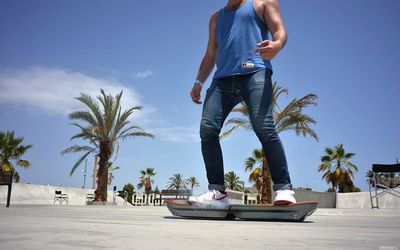HOVERBOARDS are the surprise hit of this holiday season even though they are catching fire, getting banned by airlines and being removed from retailers because of shoddy batteries and an apparent lack of quality control.
Their popularity also has led to a surprisingly far-reaching patent war.
As a result, the way innovation in hardware is nurtured and rewarded might never be the same — or at least that hopefully will be the case.
One key player in the battle is a company previously known primarily for making a very different kind of mobile device: fast-growing Chinese cellphone manufacturer Xiaomi.
That fact probably will surprise even close watchers of this space, because most of the companies involved in making hoverboards are among the legion of nameless small-time manufacturers in China.
The reason these knock-offs are so popular is simple: they sometimes cost as little as $200—a fraction of the original price, which ranges from $600 to $1,500.
The original in this case would be the Hovertrax, made by Inventist in Camas, Washington.
Inventist founder Shane Chen claims he invented the hoverboard, and holds a patent, having first filed an application in 2012. After a brief dalliance with entrepreneur Mark Cuban, Inventist last month licensed the Hovertrax to Razor USA, maker of the eponymous scooter.
One reason for the deal, says Joalene Jolivette, head of sales at Inventist, is that Razor has more resources to sue the biggest importers of hoverboards from China.
"Razor has spent over $1m inside of a week dealing with cutting off some of the knock-offs into the states," she says.
Neither Inventist nor Razor would say how many lawsuits that represents, but their legal action against the maker of IO Hawk hoverboards is public, and a lawyer for hoverboard company Swagway told me that company is being sued as well.
At this point it might sound like the patent system has done its job — to "allow someone to profit from inventions which are expensive to invent but easy to copy once made", says Christina Mulligan, an assistant professor at Brooklyn Law School who specialises in internet and intellectual property law.
But it isn’t that simple. As countless technology companies have discovered, gaining an edge on your rivals by acquiring a patent portfolio requires only money and a willing seller — not hard to find in tech, given the booming business of patent licensing.
Even before this dust-up, Mr Chen had some insight into this issue. As he battled several Chinese firms that copied some of his earlier devices, he found an ally in US mobility company Segway.
Segway even filed a complaint against Beijing-based Ninebot in September 2014 alleging the company had copied its iconic two-wheel upright scooter. Then, in March, Ninebot resolved that dispute by simply buying Segway.
Around the same time, Ninebot received an $80m investment from Xiaomi and top-tier US venture-capital firm Sequoia.
In April, Inventist sued Ninebot for allegedly copying its Solowheel, another battery-powered people mover. That case has yet to be resolved.
Ninebot responded by suing Inventist, claiming that its Hovertrax infringed on Segway’s older patents for self-balancing, wheeled vehicles.
The founder of Ninebot previously has said the primary reason he bought Segway was for its patents.
Segway CEO Rod Keller says his company is simply enforcing its intellectual property rights.
Ms Jolivette says Segway’s suit was retaliation for Inventist’s earlier suit against Ninebot.
Companies are loath to talk about pending legal action, so let me fill in the gaps of this complicated tapestry with my own theory, one that could be borne out at next month’s Consumer Electronics Show in Las Vegas.
There, Mr Keller says, Segway will unveil a product aimed at the consumer market.
He wouldn’t say whether it was a hoverboard but he intimated it would compete with them. This makes sense, as Ninebot already makes a hoverboard-like device called the Ninebot Mini.
What Ninebot/Segway and Inventist/Razor both dearly would like to achieve is a consolidation of the hoverboard market in which they are the only ones left standing. Ninebot may have the advantage. "If we enter this market, we’re the only ones who will enter it with a global brand recognised worldwide," says Mr Keller.
Xiaomi’s investment in Ninebot/Segway also gives both companies access to its supply chain of high-quality, inexpensive parts, many of which — such as batteries and gyroscopes — also go into hoverboards, Mr Keller says.
Amassing a patent trove, lining up a large manufacturing partner and buying a well-known brand sure sounds like a plan for world hoverboard domination.
And if it works, a couple of Chinese companies simultaneously will have leveraged the very different patent systems of the US, where Internet Protocol has what some say is too much protection, and China, where in practice it has almost none at all.
Meanwhile, the man with the best claim to have invented the technology in dispute, Mr Chen, will have to settle for whatever hoverboards Razor and his own company can sell until his devices are driven out of the market by cheaper Chinese models or crushed by patent litigation.
And that should make us all wonder whether our patent system is still up to the task of rewarding those who create original but eminently copyable inventions.
More Africa news from The Wall Street Journal
More news from The Wall Street Journal
Premium access to WSJ.com: $1 a week for 12 weeks

Lexus almost steered away from a plan to produce hoverboards, but the decision by Toyota’s luxury brand to stay with the venture despite early setbacks is paying off thanks to savvy use of social media. Picture: SUPPLIED
HOVERBOARDS are the surprise hit of this holiday season even though they are catching fire, getting banned by airlines and being removed from retailers because of shoddy batteries and an apparent lack of quality control.
Their popularity also has led to a surprisingly far-reaching patent war.
As a result, the way innovation in hardware is nurtured and rewarded might never be the same — or at least that hopefully will be the case.
One key player in the battle is a company previously known primarily for making a very different kind of mobile device: fast-growing Chinese cellphone manufacturer Xiaomi.
That fact probably will surprise even close watchers of this space, because most of the companies involved in making hoverboards are among the legion of nameless small-time manufacturers in China.
The reason these knock-offs are so popular is simple: they sometimes cost as little as $200—a fraction of the original price, which ranges from $600 to $1,500.
The original in this case would be the Hovertrax, made by Inventist in Camas, Washington.
Inventist founder Shane Chen claims he invented the hoverboard, and holds a patent, having first filed an application in 2012. After a brief dalliance with entrepreneur Mark Cuban, Inventist last month licensed the Hovertrax to Razor USA, maker of the eponymous scooter.
One reason for the deal, says Joalene Jolivette, head of sales at Inventist, is that Razor has more resources to sue the biggest importers of hoverboards from China.
"Razor has spent over $1m inside of a week dealing with cutting off some of the knock-offs into the states," she says.
Neither Inventist nor Razor would say how many lawsuits that represents, but their legal action against the maker of IO Hawk hoverboards is public, and a lawyer for hoverboard company Swagway told me that company is being sued as well.
At this point it might sound like the patent system has done its job — to "allow someone to profit from inventions which are expensive to invent but easy to copy once made", says Christina Mulligan, an assistant professor at Brooklyn Law School who specialises in internet and intellectual property law.
But it isn’t that simple. As countless technology companies have discovered, gaining an edge on your rivals by acquiring a patent portfolio requires only money and a willing seller — not hard to find in tech, given the booming business of patent licensing.
Even before this dust-up, Mr Chen had some insight into this issue. As he battled several Chinese firms that copied some of his earlier devices, he found an ally in US mobility company Segway.
Segway even filed a complaint against Beijing-based Ninebot in September 2014 alleging the company had copied its iconic two-wheel upright scooter. Then, in March, Ninebot resolved that dispute by simply buying Segway.
Around the same time, Ninebot received an $80m investment from Xiaomi and top-tier US venture-capital firm Sequoia.
In April, Inventist sued Ninebot for allegedly copying its Solowheel, another battery-powered people mover. That case has yet to be resolved.
Ninebot responded by suing Inventist, claiming that its Hovertrax infringed on Segway’s older patents for self-balancing, wheeled vehicles.
The founder of Ninebot previously has said the primary reason he bought Segway was for its patents.
Segway CEO Rod Keller says his company is simply enforcing its intellectual property rights.
Ms Jolivette says Segway’s suit was retaliation for Inventist’s earlier suit against Ninebot.
Companies are loath to talk about pending legal action, so let me fill in the gaps of this complicated tapestry with my own theory, one that could be borne out at next month’s Consumer Electronics Show in Las Vegas.
There, Mr Keller says, Segway will unveil a product aimed at the consumer market.
He wouldn’t say whether it was a hoverboard but he intimated it would compete with them. This makes sense, as Ninebot already makes a hoverboard-like device called the Ninebot Mini.
What Ninebot/Segway and Inventist/Razor both dearly would like to achieve is a consolidation of the hoverboard market in which they are the only ones left standing. Ninebot may have the advantage. "If we enter this market, we’re the only ones who will enter it with a global brand recognised worldwide," says Mr Keller.
Xiaomi’s investment in Ninebot/Segway also gives both companies access to its supply chain of high-quality, inexpensive parts, many of which — such as batteries and gyroscopes — also go into hoverboards, Mr Keller says.
Amassing a patent trove, lining up a large manufacturing partner and buying a well-known brand sure sounds like a plan for world hoverboard domination.
And if it works, a couple of Chinese companies simultaneously will have leveraged the very different patent systems of the US, where Internet Protocol has what some say is too much protection, and China, where in practice it has almost none at all.
Meanwhile, the man with the best claim to have invented the technology in dispute, Mr Chen, will have to settle for whatever hoverboards Razor and his own company can sell until his devices are driven out of the market by cheaper Chinese models or crushed by patent litigation.
And that should make us all wonder whether our patent system is still up to the task of rewarding those who create original but eminently copyable inventions.
More Africa news from The Wall Street Journal
More news from The Wall Street Journal
Premium access to WSJ.com: $1 a week for 12 weeks





















Change: 2.98%
Change: 3.39%
Change: 2.94%
Change: 3.00%
Change: 5.00%
Data supplied by Profile Data
Change: 0.00%
Change: 0.00%
Change: 2.98%
Change: 0.00%
Change: 0.00%
Data supplied by Profile Data
Change: 0.00%
Change: -0.01%
Change: 0.01%
Change: 0.00%
Change: -0.58%
Data supplied by Profile Data
Change: 0.00%
Change: 0.00%
Change: 0.00%
Change: 0.00%
Change: 0.00%
Data supplied by Profile Data